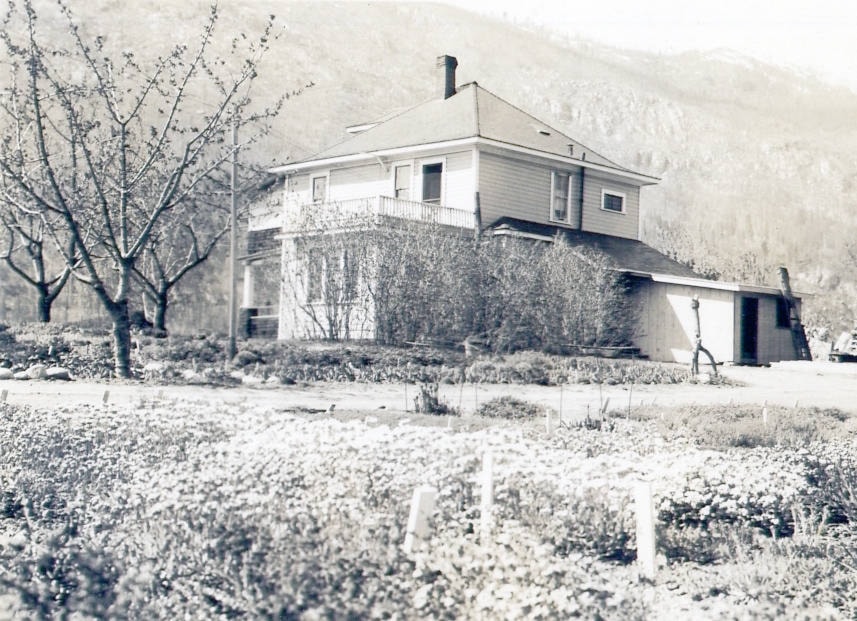The war years saw major changes at Riverview.
Duncan enlisted in the Royal Canadian Air Force, and was away when his father-in-law, Charles Squires, died in April 1941 of a heart attack at age 61. According to his obituary, he had… worked tirelessly for better marketing conditions for fruit farmers.
At the time of his death he was president of the Robson Cooperative Exchange and the Arrow Lakes representative of the BC Fruit Growers Association.
Dr. McDiarmid now found himself sole manager of Riverview as well as of a much smaller household. A decision was made to lease out the Riverview operation to the Robson Cooperative Exchange until Duncan returned from the war service. In the summer of 1945 the ‘Let’s Cooperate’ newsletter advised its members:
“Back from the Armed Forces: Mr. Duncan Carter has been away since the commencement of hostilities. His absence has been keenly felt here in Robson. Welcome home Mr. Carter!”
The same newsletter mentions problems with new pests of which the ‘Little Cherry’ disease was the most worrisome. Now we know that it is caused by a virus that is spread by insects, most commonly the apple mealybug. It was introduced to North America with imported ornamental flowering cherry trees. Although it was first documented in the Kootenay region as early as 1933, the Blaylock estate grounds may have played a role in its dissemination.
As 1945 was ending, Reverend McDiarmid was suffering from a heart ailment and sensed a growing weakness overcoming him. In his last letter, which he wrote to a friend on Dec. 17, he acknowledged the change, but he was accepting of what he saw coming:
“I am looking forward to the coming Christmas as probably the last I shall know here. I am looking forward to experiences in a brighter world before the next comes. What a blessing &comfort to have such a hope! What a wonderful Saviour &salvation we have!”
He died on Jan. 24, 1946 at the age of 93.
That year would see other significant changes at the Robson Cooperative Exchange.
In the spring its holdings were expanded by the acquisition of the Robson Store and a store manager was hired. Now members had access to groceries as well as agricultural supplies, coal, and Marconi radios. As prices were set on a non-profit basis, the move was not favoured by independent retailers, who were losing customers.
DDT was still sold to members as a fly-control agent for 70 cents a quart in spite of period magazine articles that started to question its utility as a non-selective insecticide, which ‘may kill plants’ friends and preserve their foes.’ Its real devastating effect on a much wider environment was yet to be documented.
The new indebtedness combined with other problems and in December 1946 the entire Board of Directors resigned in response to a vote of non-confidence.
By 1948 Duncan Carter was president of the Robson Cooperative Exchange. Valiant efforts were made to at least partly pay off creditors. He was still at the helm in 1952 when it was becoming apparent that major changes were eventually going to overwhelm the pristine Arrow Lakes valley.
The first of these was the establishment of the huge Celgar pulp mill and sawmill complex directly across the river.
Following on its heels was the Columbia River Treaty, which effectively dealt the final blow to what was still left of the Arrow Lakes fruit industry.
Against this sad background the Carter family carried on as best they could. By 1950 Eleanor and Duncan were living in a new house which had been built on the south end of Block 32. A son, John, was born to them in 1945. He was raised to enjoy the great outdoors and to worship the mountains. He would become a trail builder and an inspiration to many, including myself.
Riverview took on a new life after the retirement of the last members of the original venture.
The land with the old orchards was bought by BC Hydro for the establishment of a dam-construction townsite. An acre with the McDiarmid house on it was sold to Dwayne Davis, who modified the house somewhat.
Nora and Harry Jukes purchased the property in 1981, and Nora’s Garden became a highlight of Robson.
The old house and its gardens, as well as the Squires photographic record were catalysts that led to a reawakening of those remarkable times through the Richard Widdifield mural that now graces Robson Community School.
I am much indebted to Nora Jukes and Ken Wyllie for the documentation behind this series of essays.
